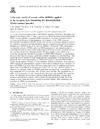Please use this identifier to cite or link to this item:
https://accedacris.ulpgc.es/jspui/handle/10553/12825
| Title: | A dynamic model of oceanic sulfur (DMOS) applied to the Sargasso Sea: Simulating the dimethylsulfide (DMS) summer paradox | Authors: | Vallina, Sergio M. Simó, Rafael Anderson, T. R. Gabric, Albert J. Cropp, R. Pacheco Castelao, José Miguel |
UNESCO Clasification: | 251007 Oceanografía física 12 Matemáticas |
Keywords: | Atlantic Time-Series Dimethylsulfoniopropionate Dmsp Solar-Radiation Phytoplankton Community Marine Dimethylsulfide, et al |
Issue Date: | 2008 | Journal: | Journal Of Geophysical Research-Biogeosciences | Abstract: | A new one-dimensional model of DMSP/DMS dynamics (DMOS) is developed and applied to the Sargasso Sea in order to explain what drives the observed dimethylsulfide (DMS) summer paradox: a summer DMS concentration maximum concurrent with a minimum in the biomass of phytoplankton, the producers of the DMS precursor dimethylsulfoniopropionate (DMSP). Several mechanisms have been postulated to explain this mismatch: a succession in phytoplankton species composition towards higher relative abundances of DMSP producers in summer; inhibition of bacterial DMS consumption by ultraviolet radiation (UVR); and direct DMS production by phytoplankton due to UVR-induced oxidative stress. None of these hypothetical mechanisms, except for the first one, has been tested with a dynamic model. We have coupled a new sulfur cycle model that incorporates the latest knowledge on DMSP/DMS dynamics to a preexisting nitrogen/carbon-based ecological model that explicitly simulates the microbial-loop. This allows the role of bacteria in DMS production and consumption to be represented and quantified. The main improvements of DMOS with respect to previous DMSP/DMS models are the explicit inclusion of: solar-radiation inhibition of bacterial sulfur uptakes; DMS exudation by phytoplankton caused by solar-radiation-induced stress; and uptake of dissolved DMSP by phytoplankton. We have conducted a series of modeling experiments where some of the DMOS sulfur paths are turned “off” or “on,” and the results on chlorophyll-a, bacteria, DMS, and DMSP (particulate and dissolved) concentrations have been compared with climatological data of these same variables. The simulated rate of sulfur cycling processes are also compared with the scarce data available from previous works. All processes seem to play a role in driving DMS seasonality. Among them, however, solar-radiation-induced DMS exudation by phytoplankton stands out as the process without which the model is unable to produce realistic DMS simulations and reproduce the DMS summer paradox. | URI: | https://accedacris.ulpgc.es/handle/10553/12825 | ISSN: | 2169-8953 | DOI: | 10.1029/2007JG000415 | Source: | Geophysical research letters, American Geophysical Union [ISSN 2169-8953], v. 113 G1), G01009, (Marzo 2008) | Rights: | by-nc-nd |
| Appears in Collections: | Artículos |
SCOPUSTM
Citations
49
checked on Jun 8, 2025
WEB OF SCIENCETM
Citations
47
checked on Jun 8, 2025
Page view(s)
216
checked on Jul 12, 2025
Download(s)
208
checked on Jul 12, 2025
Google ScholarTM
Check
Altmetric
Share
Export metadata
Items in accedaCRIS are protected by copyright, with all rights reserved, unless otherwise indicated.
